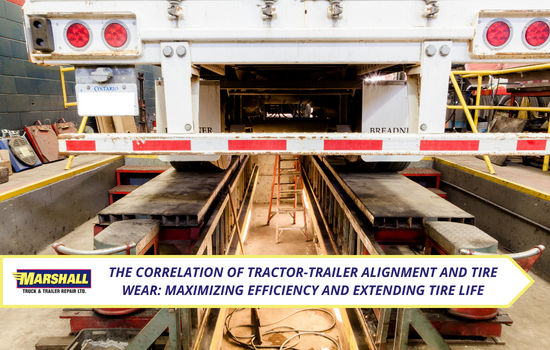Maintaining proper alignment is essential for the optimal performance and safety of tractor-trailers. The alignment of your truck and trailer has a direct impact on the longevity and condition of your tires.
Where Efficiency Meets Tread: The Relationship Between Tractor-Trailer Alignment and Tire Wear
 One area where alignment plays a significant role is tire wear. Your tractor-trailer’s alignment has a major impact on your truck and trailer, in another blog, we discussed the correlation between fuel economy and heavy truck rear axle alignment.
One area where alignment plays a significant role is tire wear. Your tractor-trailer’s alignment has a major impact on your truck and trailer, in another blog, we discussed the correlation between fuel economy and heavy truck rear axle alignment.
In this blog, we will explore the correlation between tractor-trailer alignment and tire wear, highlighting the importance of alignment for maximizing efficiency, and safety, and extending tire life for your truck and trailer.
Understanding Tractor-Trailer Alignment
Tractor-trailer alignment refers to the precise positioning of the vehicle's wheels and axles. Proper alignment ensures that all wheels are parallel to each other and perpendicular to the road surface. Alignment includes three key measurements:
- toe (inward or outward tilt);
- camber (vertical tilt), and;
- caster (steering axis inclination).
When these measurements are within manufacturer specifications, the truck and trailer operate optimally.
Uneven Tire Wear
Improper alignment can lead to uneven tire wear patterns, reducing tire lifespan and compromising safety. Misalignment causes excessive tire wear in specific areas, such as the inside or outside edges, resulting in irregular tread wear.
Common types of uneven tire wear caused by alignment issues include feathering, cupping, and scalloping:
- Feathering: Feathering refers to a pattern where the tread ribs on one side of the tire are worn smoother than the other side. This occurs when the toe alignment is misadjusted, causing the tires to point slightly inward or outward. Feathering can lead to increased rolling resistance, reduced fuel efficiency, and a noisier ride.
- Cupping/Scalloping: Cupping, also known as scalloping or dipping, appears as a series of irregular dips or wear spots along the tread surface. It is often caused by inconsistent tire contact with the road surface due to misalignment. Cupping can result in a rough and noisy ride, reduced traction, and an increased risk of tire failure.
Effect on Tire Life and Cost
Misalignment accelerates tire wear, significantly reducing tire life. Premature tire wear leads to frequent replacements, which can be a significant expense for fleet owners. By maintaining proper alignment, you can extend tire life, decrease downtime for replacements, and reduce overall truck operating costs.
Safety Considerations
Proper alignment not only extends tire life but also contributes to safe operation. Misaligned tractor-trailers experience compromised handling, reduced stability, and decreased braking efficiency. This increases the risk of accidents, especially in adverse weather conditions. Alignment maintenance plays a vital role in ensuring driver and road safety.
Regular Alignment Checks
To mitigate the impact of misalignment on tire wear, it is crucial to conduct regular alignment checks. Marshall Truck & Trailer Repair qualified technicians can assist with periodic inspections to identify alignment issues early on, allowing for timely adjustments and corrections. Fleet owners should establish maintenance schedules that include alignment checks to maintain optimal tire performance and minimize wear for all trucks and trailers.
Maintaining proper alignment is paramount for tractor-trailers to maximize efficiency and extend tire life. Remember Marshall Truck & Trailer Repair is a Michelin® & Tirecraft® Tire Dealer. If you require new tires or would like to book an appointment to have your alignment checked, please do not hesitate to contact us.
